For Renegade Ambulance Riders,
the Man in the Minivan
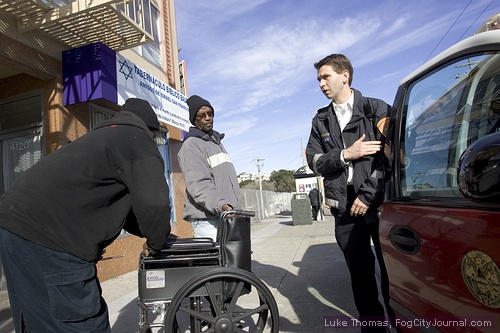
San Francisco Fire Department Captain Neils Tangherlini is not
your usual firefighter
or emergency technician. Working alone, his mission is to connect
frequent flyers, those who routinely abuse expensive emergency
services for non-emergencies, with the services and assistance
they need.
Photo(s) by
Luke Thomas
By Emmett
Berg
December 17, 2007
Mr. R is flat on his back, and turns away best he can from the
man in uniform. San Francisco Fire Capt. Niels Tangherlini asks
Mr. R. where he can find him later if he wants to decide later
to come in from the streets.
"I be everywhere," Mr. R said. "I got no turf."
He looks like he wants more shuteye.
Capt. Tangherlini persists, his voice conversational about the
"good stuff" in housing and services he can offer, as
long as he can find him or at least know where to look. Mr. R
knows we're watching, and it looks like he wants to try.
A minute later, Mr. R turns his head over and says: "I'll
be here."
That's an unacceptable forwarding address, given that Mr. R.
is in a bed parked in hallways of the emergency department at
San Francisco General Hospital.
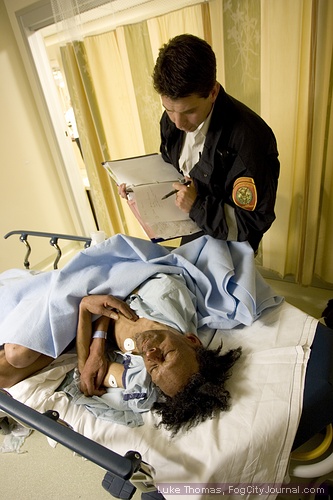
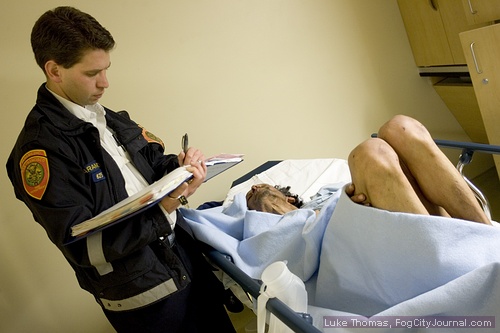
Mr. R is one of about a half dozen people laid out on stretchers
in the hallways of the ER, still dozing at 9:30 a.m. on a recent
Monday. Some gentle snoring audible, the most fuss we heard was
from a gentle nurse exhorting a woman to sit up and eat a breakfast
sandwich.
In the interim before the hallway sleepers are kicked out of
emergency, Tangherlini is seizing the moment. A systems buster
for chronic inebriants like Mr. R., Tangherlini takes a paramedic's
background to the job with a social worker's calm assurance. Tangherlini
works closely with hard cases, and steers them the city's two
Homeless Outreach Teams of licensed clinical social workers, people
who in turn can lead the way to housing and help.
On hospital beds here at General include renowned "frequent
flyers" - people requiring recurrent, sometimes daily paramedic
transport to area hospitals. The wasted resources stack up when
the same person requires a hundred or more ambulance rides in
a single year.
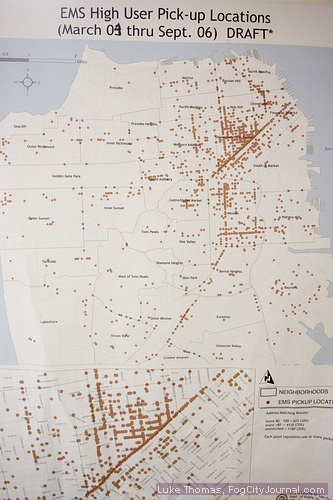
A map of San Francisco illustrates a majority of frequent flyer
calls
orginate in the Tenderloin and downtain areas of San Francisco.
Passion for the job can erode when ambulance crews are dispatched
to the same people over and over because of chronic inebriation.
Clients who call for help can become abusive of paramedic staff.
Worries that a paramedic will witness murder in the course of
domestic violence, or be hurt while on a case, are more than just
fears: they happen.
The memory of a partner who quit paramedic work in part led Tangherlini
to pursue a degree in social work in a quest to "change the
experience" for doctors, nurses and emergency responders.
Now his special assignment follows a route trod also by chronic
users: the Tenderloin, intensive case management centers, and
the emergency room.
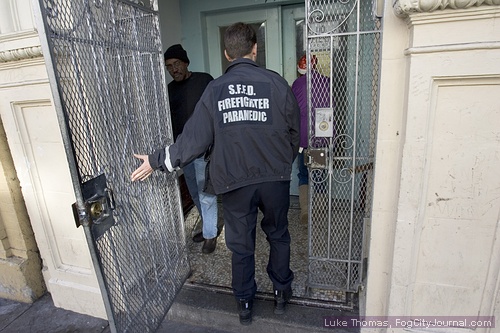
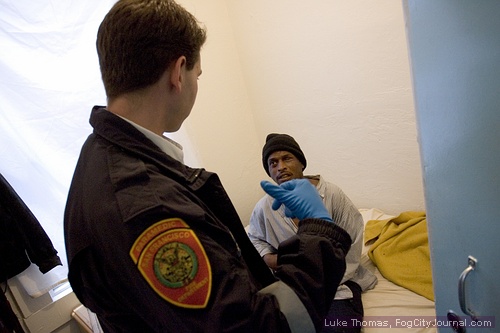
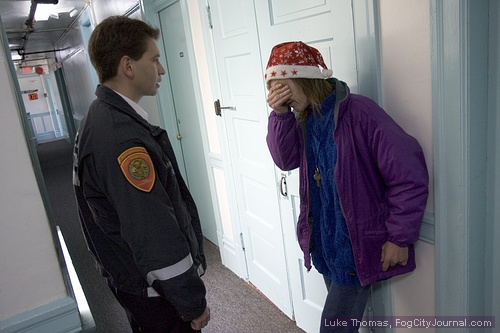
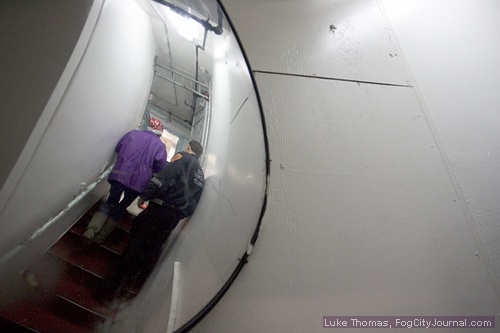
As Tangherlini was making his pitch to other patients in the
hallway, his cell phone rang and his face lit up with the realization
it was Ms. A., a known renegade in three counties. By Tangerhlini's
estimation, Ms. A rides ambulances more than 100 times a year
for the past few years running. And here was Ms. A calling on
the cell phone saying she had decided to come in from the streets
into supportive housing.
"This would be big," he said in the minivan on the
way over to the Oshun Center for women at Turk and Taylor streets.
At the Oshun Center, the hardscrabble experience of staff, some
who are recovering addicts, adds credibility as they work to help
the Tenderloin homeless and other women in dire need. A staff
member says she confides in prospective clients, telling them,
"I know what hard dope is. I'm just feelin' today, is all."
Still it can be hard to gauge the resolve in another's eye.
Ms. A greets us but stays seated in her chair in the front room
of the Oshun Center. A kind of courtship ritual unfolds and Ms.
A., sated it seems, appears ready to follow Tangherlini into the
minivan. But then her dismay is evident when another client seated
in a nearby sofa asks staff to call an ambulance because of pain
in her legs.
While the call is made, Tangherlini crosses the room to assist
her. Eventually a S.F. Fire Department paramedic crew arrives,
one of them groaning at the woman, "Not you again."
With the handful of paramedics focused on the other woman, Ms.
A changes her mind and gets up to leave. Ms. A said it was too
early, at noontime on a nice day, to go "into services,"
Ms A said. She said she was just going down the street and we
could find her.
When Tangherlini disentangled himself, we combed the streets
in the minivan.
No Ms. A
"She's had a history of saying she was done and then running
out like this," Tangherlini said.
* * *
Update: Ms. A entered permanent supportive housing last week,
according to the city's housing and urban health medical director
Dr. Josh Bamberger. Ms. A's chances of staying there are much
better than average.
Bamberger said the city's 4,000 units of permanent housing for
the homeless had a 90 percent retention rate over the last year.
The remaining 10 percent, he said, were moving to other housing
or supporting service programs. Evictions comprise 2 or 3 percent.
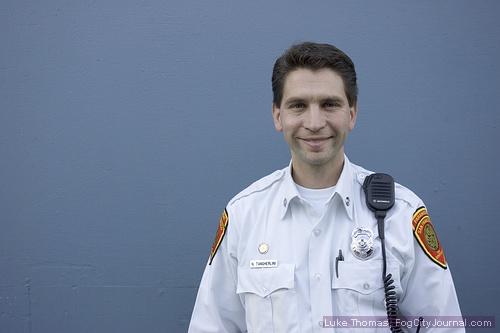
Captain Neils Tangherlini
Permalink
####
|